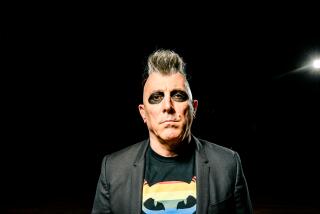ART : BETWEEN THE LINES : Yoko Ono Adds Color and Text to Work of Fellow Artist John Lennon
Although he must be the most famous person ever to attend the Liverpool College of Art in England, John Lennon surely would never have made his mark on 20th-Century culture had he stuck to drawing the knobby caricatures that were his youthful forte.
But as the legacy of a martyred rock hero, killed in 1980 by a delusional fan now serving a life sentence, the drawings he made in the post-Beatles years--reproduced by master printers as serigraphs or lithographs--have acquired a certain nostalgic allure.
The prints celebrate his married life with Yoko Ono, from the couple’s Amsterdam “Bed-In for Peace” in 1969 to scenes of domestic bliss from the late ‘70s, when he stayed home to care for their infant son, Sean.
A selection of Lennon’s prints and drawings--a traveling show circulated in the United States and Canada by Pacific Edge Gallery in Laguna Beach--is at the gallery through March 26. (Many of the works are for sale, for prices ranging from $200 to $12,000 for the signed 14-piece “Bag One” suite from 1970, in an edition of 300. Packaged in a white leather designer bag, those lithographs had their own 15 minutes of fame when police confiscated eight allegedly “indecent” prints from a London gallery where the set was first shown. The case was dismissed several months later.)
Ono’s release of the first posthumous editions of Lennon’s prints in 1986 was the initial impetus for Pacific Edge owner Paul C. Jillson--a former musician and longtime Beatles fan who otherwise exclusively shows work by two Laguna Beach artists--to hook up with the Lennon estate.
Ono, of course, was the real thing: a Tokyo-born avant-garde artist who had burst onto the New York scene in the late 1950s with startling conceptual works. Part of the Zen-influenced Fluxus group, which included composers John Cage and Terry Riley, video artist Nam June Paik and sculptor Walter De Maria, Ono turned everyday activities into intensely concentrated events evoking wonder or pain.
Her austere “instruction pieces” invited viewers to do such things as “light a match and watch till it goes out” or “draw a line with yourself; go on drawing until you disappear.” Her performances attempted to evoke such intangibles as “the sounds of people’s fears.”
In a recent phone conversation from her Manhattan home, Ono, 62, spoke with warmth and humor of Lennon’s art and their symbiotic artistic life.
“Most people think, why was he always (drawing) the family?” she said. “But this is a very normal thing for artists to do. For ages, artists have been using their wives and children as models. For him there was an added element (in making sketches) in that he just liked to quickly do things, things around him. He would never go back and retouch.”
A few of the prints--like “The Hole of My Life” (1979) and “Taste” (1977) appear to be Lennon’s attempts to summon up Ono’s conceptual rigor. (In “Hole,” a large black dot represents a personal void; in “Taste,” a set of caricatured faces represent various kinds of tastes.)
But Ono disagrees. “He was very surreal from the beginning,” she said. “The drawings from ‘In His Own Write’ (his first book, published in 1964) were very surrealistic--people buried in the ground, sticking their heads out or whatever, looking very strange and ugly. His drawings were very close to George Grosz,” the German-born Expressionist famous for satirical social sketches.
Indeed, as Ray Coleman notes in his 1984 biography “Lennon,” John had a strange early predilection for drawing people with physical afflictions, as well as an offbeat sense of artistic humor. (He once emerged from his weekly life drawing class at the art college having drawn only the model’s wristwatch.)
Nor does Ono take credit for Lennon’s adult fascination with the rhythmic strokes of Asian brush painting. “We went to Japan (in 1977), and he discovered Oriental technique by himself,” she said.
Intrigued by the classical Japanese practice of signing prints with a personal seal in Chinese calligraphy, Lennon also decided he wanted his own seal, Ono said. The red seal visible on the lower right-hand corner of each print phonetically imitates Lennon’s name and, according to Ono, translates as, “beautiful sound as a cloud.”
A note in the catalogue accompanying the show says that Ono hand-colored the prints. Wasn’t that a waste of her talents?
“It was all just to help and support his work, like doing an interview,” she said dryly. “In the beginning, it was hard to push him out there. You would think, wouldn’t any gallery jump at the opportunity? But in the art world there was a snobbery. A gallery said, ‘We don’t do that sort of thing. We don’t want that sort of (celebrity art) image.’ ”
Other galleries proposed coloring the prints to make them more salable. “Through being with John, I was a more pragmatic person,” Ono said. “In the record world, you would do an (album) cover and you would think it was artistic. And they’d say, well, you can’t put that in shop windows. I didn’t want anybody else to color the prints (after Lennon’s death). But I did it. I tried to color them in such a way that the color is not overwhelming, that it wouldn’t destroy the original touch.
“Nowadays, doing a celebrity gallery show is something people don’t hesitate (about). But I think John is in a separate category. He did go to art school, and he was an artist when I met him. . . . He was adopting a kind of animation technique. (New York artists) Keith Haring and Kenny Scharf were (doing that kind of work) in the late ‘70s, and it became a kind of accepted technique in the art world. In that sense, John was--well, not avant-garde, but before his time.”
Ono credits both her Japanese roots (“the kind of minimalism that existed in haiku poetry”) and her friendships with experimental musicians of the ‘50s--particularly Cage, Richard Maxfield and La Monte Young--for the impetus behind her own work, which is not in the Pacific Edge show.
Ono was determined to find a mode of expression different from that of her conservatively cultured family. Her meeting with Cage, she said, was “the singularly important moment in the sense that it was an affirmation and a confirmation that, as a black sheep, I was going in the right direction.”
As it happens, Lennon first met Ono at her 1966 Indica Gallery show in London, “Unfinished Paintings and Objects.” Five years later, he told Rolling Stone magazine that he had heard “this amazing woman” would be putting people in black bags. (One work illustrated in the catalogue was a large black bag with the caption: “With a member of the audience inside.”)
For him, the show was a lark to fill the down time between records. But for her, it was serious business; cloistered within a rarefied zone of the art world, she had never even heard of Lennon.
One of Ono’s works in the exhibition proposed that the viewer pay 5 shillings for the privilege of hammering a nail into a board. He playfully refused, saying he’d pay nothing and hammer in an imaginary nail.
“Then he asked me what the event was that day,” Ono remembered. “I showed him the card (it said, ‘Breathe’), and he was taken aback. He expected some show with a naked woman in a bag. And he bit into the apple (a real apple, provocatively priced at 200 pounds).
“I was very upset. How dare he just bite into the work? I showed the anger, and he was looking like a little kid doing something naughty.”
Lennon climbed a ladder in the gallery that led to a painting with an attached spyglass; when you looked through it, the painting said, “Yes.”
“He didn’t tell me how great it was at the time,” Ono said, laughing. “He came down the ladder and smiled and left the gallery.”
It was a meeting of opposites. Some say the influence of her feminist and political beliefs on Lennon was one of Ono’s most effective conceptual pieces. She won’t go that far, but she does celebrate their collusion of differences.
“His background was working class, and it had a power of its own. What was good about being together was the fact that we were totally different from each other but giving each other power.
“There was a drawing I did, an abstract drawing of two people watching TV. He looked at it and made a drawing of two very real people watching TV. There was that dialogue, and I enjoyed it. He taught me to be pragmatic and realistic, which was incredible. To come out of that ivory tower and get real--that was an important learning process for me, for my survival now. It was like a Zen shock he gave me.”
* What: “A Tribute to the Art of John Lennon.”
* When: Through March 26. Gallery hours: 11 a.m. to 6 p.m. Wednesdays through Sundays, 1 to 5 p.m. Mondays and Tuesdays.
* Where: Pacific Edge Gallery, 540 S. Coast Highway, No. 112, Laguna Beach.
* Whereabouts: San Diego (405) Freeway to Laguna Canyon Road (Highway 133); turn left at Coast Highway.
* Wherewithal: Admission is FREE.
* Where to call: (714) 494-0491.
MORE ART
IN NEWPORT BEACH: JOCHEN GERZ
“Jochen Gerz: People Speak,” at Newport Harbor Art Museum through March 19, is a retrospective of the text-and-image work of a German artist interested in the variable, uncertain way people process information through memory and sense impressions. (714) 759-1122.
IN FULLERTON: “YOU ARE HERE”
In his walk-through installation at Cal State Fullerton’s Main Art Gallery through Sunday, March 12, Daniel Wheeler combines a discursive philosophical breadth with a knack for juxtaposing visually compelling objects and sensory experiences. (714) 773-3262.
IN COSTA MESA: GREEK LEGACY
Greek icons, carvings, textiles, costumes, silver work, jewelry, masks, puppets, musical instruments and furniture dating from the 18th to the 20th centuries illuminate the “Greek Legacy” at Orange Coast College Art Gallery, through April 20. (714) 432-5039.
More to Read
The biggest entertainment stories
Get our big stories about Hollywood, film, television, music, arts, culture and more right in your inbox as soon as they publish.
You may occasionally receive promotional content from the Los Angeles Times.






